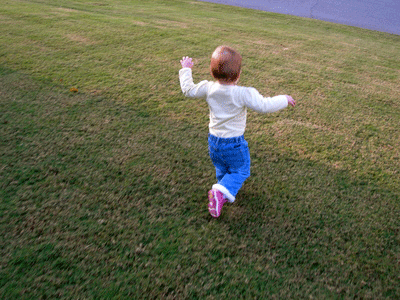One of the best analogies I have ever come across for meditation practice is a baby learning to walk.

I remember my daughter taking her first step when she was about nine months old. One beautiful step. But one step was all she could manage before she would fall, in the uber-cute way that only babies can fall (everybody say, “awwwww”). Eventually, she graduated from one step to two steps. And then she plateaued for a while. For a couple of months, she could walk no more than one or two steps before she would fall (awwwww).
Then a few days after her first birthday, I noticed her walking four steps. That same day, she doubled that achievement and maxed out at eight steps. (Yes, I measured, I’m an engineer, remember?) The next day, she seemed to plateau at eight steps, but in the late afternoon, she managed 16 steps before she fell. In the evening, she exceeded 30 steps. Once she broke that barrier, she could walk. On that day, she mastered walking (awwwww).
I found an important similarity between that experience and my own meditation practice. There seems to be two stages in one’s meditation progress. I call the two stages “initial access” and “consolidation.” The “initial access” stage is when you find yourself able to access a certain state of mind, but you can’t maintain that mind for very long.
For example, you may serendipitously find yourself in a state of mind where you are very calm and alert, and feel a deep sense of joy permeating your mind, but after just a few minutes you lose it. This stage is like a baby taking her very first step. The baby is finally able to access the experience of “walking.” She finally knows what it feels like, but it only lasts a single step, maybe two, and then it’s over.
The “consolidation” stage is the long process of going from one step to being able to walk around the house. For the meditator, it is becoming able to bring up a state of mind on demand, at a desired intensity and duration. Progress in this stage seems to be an exponential function that looks like a hockey stick on a graph, which means that you go for a frustratingly long time seemingly without any meaningful progress, and then suddenly, boom, within a very short period, you make huge progress and arrive at full consolidation.
It’s like my daughter plateauing at two steps for months, and then suddenly, in the space of two days, she became able to walk. To the casual observer, it may look like she learned to walk in just two days, but in reality, she did it over three months. It is her constant practice over three months than enabled the last two days of sudden progress and mastery.
I think the lesson to be learned is to not feel discouraged when your meditation doesn’t seem to be progressing. If you understand the process, you may understand that when change does come it will come suddenly, and every moment of effort brings you a little closer to that point.
The classical analogy is the breaking up of the ice over a frozen lake. To a casual observer, the breakup seems like a sudden phenomenon, but it was actually due to a long period of gradual melting of the underlying ice structure. In Zen, we call it gradual effort and sudden enlightenment.
So the next time you see a baby learn to walk, pay some attention. That baby is really a Zen Master teaching you a thing or two about progress in your meditation (everybody say, “awwwww”).
Author : Chade-Meng Tan
Source : http://www.huffingtonpost.com




